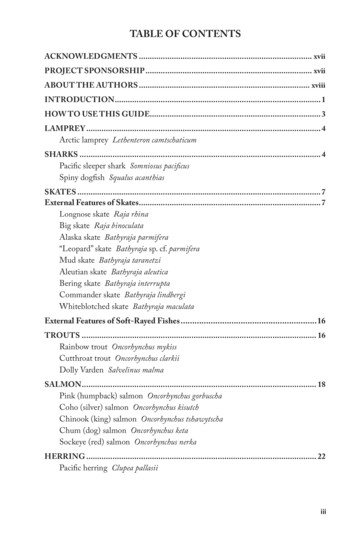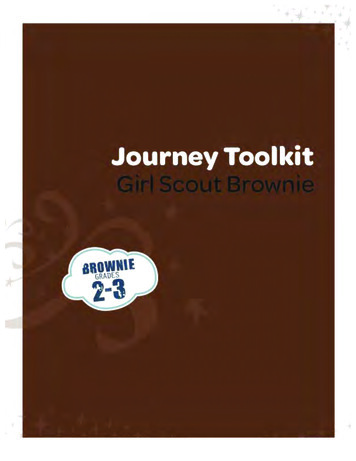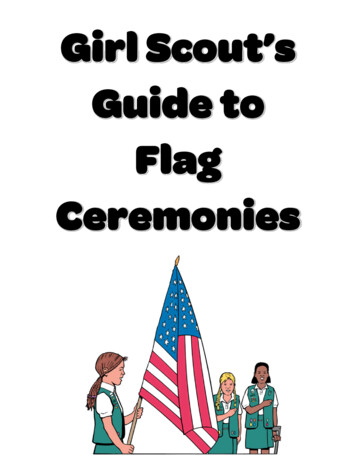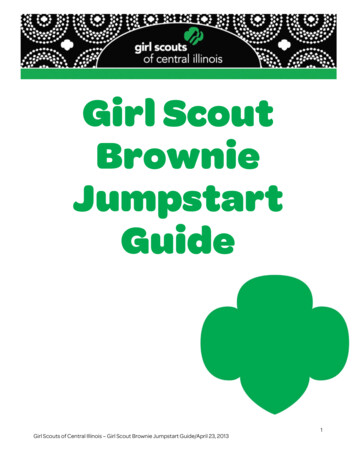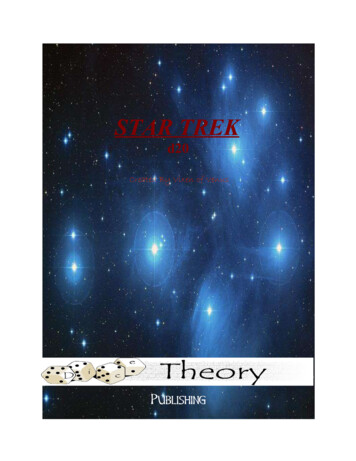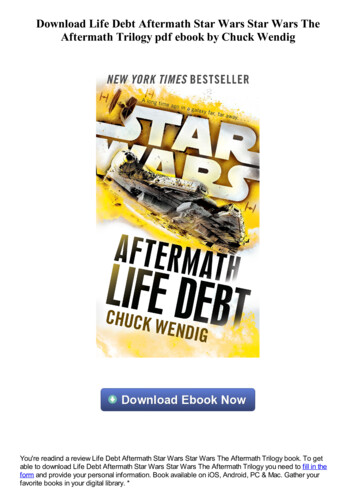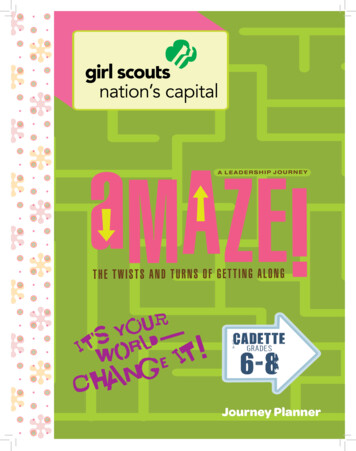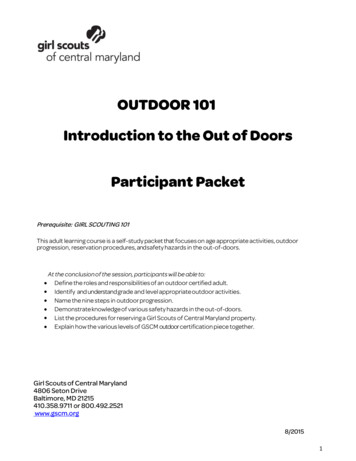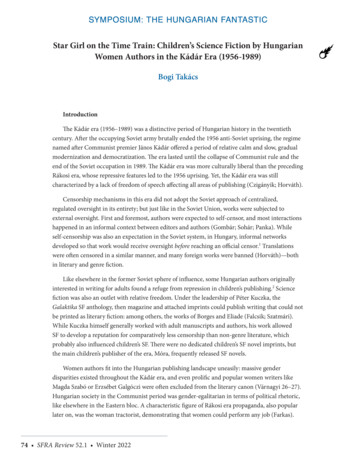
Transcription
SYMPOSIUM: THE HUNGARIAN FANTASTICStar Girl on the Time Train: Children’s Science Fiction by HungarianWomen Authors in the Kádár Era (1956-1989)Bogi TakácsIntroductionThe Kádár era (1956–1989) was a distinctive period of Hungarian history in the twentiethcentury. After the occupying Soviet army brutally ended the 1956 anti-Soviet uprising, the regimenamed after Communist premier János Kádár offered a period of relative calm and slow, gradualmodernization and democratization. The era lasted until the collapse of Communist rule and theend of the Soviet occupation in 1989. The Kádár era was more culturally liberal than the precedingRákosi era, whose repressive features led to the 1956 uprising. Yet, the Kádár era was stillcharacterized by a lack of freedom of speech affecting all areas of publishing (Czigányik; Horváth).Censorship mechanisms in this era did not adopt the Soviet approach of centralized,regulated oversight in its entirety; but just like in the Soviet Union, works were subjected toexternal oversight. First and foremost, authors were expected to self-censor, and most interactionshappened in an informal context between editors and authors (Gombár; Sohár; Panka). Whileself-censorship was also an expectation in the Soviet system, in Hungary, informal networksdeveloped so that work would receive oversight before reaching an official censor.1 Translationswere often censored in a similar manner, and many foreign works were banned (Horváth)—bothin literary and genre fiction.Like elsewhere in the former Soviet sphere of influence, some Hungarian authors originallyinterested in writing for adults found a refuge from repression in children’s publishing.2 Sciencefiction was also an outlet with relative freedom. Under the leadership of Péter Kuczka, theGalaktika SF anthology, then magazine and attached imprints could publish writing that could notbe printed as literary fiction: among others, the works of Borges and Eliade (Falcsik; Szatmári).While Kuczka himself generally worked with adult manuscripts and authors, his work allowedSF to develop a reputation for comparatively less censorship than non-genre literature, whichprobably also influenced children’s SF. There were no dedicated children’s SF novel imprints, butthe main children’s publisher of the era, Móra, frequently released SF novels.Women authors fit into the Hungarian publishing landscape uneasily: massive genderdisparities existed throughout the Kádár era, and even prolific and popular women writers likeMagda Szabó or Erzsébet Galgóczi were often excluded from the literary canon (Várnagyi 26–27).Hungarian society in the Communist period was gender-egalitarian in terms of political rhetoric,like elsewhere in the Eastern bloc. A characteristic figure of Rákosi era propaganda, also popularlater on, was the woman tractorist, demonstrating that women could perform any job (Farkas).74 SFRA Review 52.1 Winter 2022
SYMPOSIUM: THE HUNGARIAN FANTASTICHungarian Children's SFHowever, society remained sexist in everyday practice (Kiss). People were legally mandated towork regardless of gender, citing the ideological approach of Engels that this was a precondition ofachieving true gender equality; but while the expression ‘working woman’ (dolgozó nő) was oftenused in propaganda and common parlance alike, there was no parallel ‘working man’ (Göndör123-124). While most people were employed, forcibly or not, women were also expected tomanage the household and child-rearing—with men often not participating in these tasks, or onlyto a severely limited extent.3 Women intellectuals sometimes turned to translation as a form ofwork that could be performed in a flexible time frame and while maintaining a work-from-homelifestyle, or even during maternity leave (Sohár 17); and the same probably holds true for writingin general.All these trends combined in the case of women authors of children’s SF. While the publishingindustry was not gender-egalitarian, the nature of the work allowed for relative flexibility: bothchildren’s publishing and SF were less affected by restrictions on freedom of speech, and the laborof writing itself allowed people to choose when and where to work. In this time period, womenauthors often worked full time either as writers or in some other related job in the industry (e.g.,in editorial), a form of employment comparatively less common among Hungarian womenauthors today. Still, women writers had a variety of motivations in choosing these career paths.Some turned to children’s publishing after having been excluded from adult publishing and thenreturned to fiction for adults after the Communist regime collapsed, but some continued to writefor children.Research QuestionsTo investigate children’s SF by women authors in the Kádár era, I outline three researchquestions:1. What were the children’s SF books by Hungarian women authors produced in this timeperiod? (i.e., a comprehensive survey of all available works produced by systematic search,which had not been conducted previously.)2. How can we characterize the speculative settings these works presented, and how did theydepict future societies? By so doing, how did they reach and/or subvert the desired aims ofthe Communist state?3. How did these speculative worlds relate to women authors’ social-political context, andhow did they fit into their authors’ oeuvres?MethodsI constructed a comprehensive list of children’s SF books by Hungarian women authorsSFRA Review 52.1 Winter 2022 75
SYMPOSIUM: THE HUNGARIAN FANTASTICHungarian Children's SFpublished in the Kádár era using the following methods:1. Searching in my own collection of Hungarian SF from this time period2. Searching on Moly.hu (the largest Hungarian social book website akin to GoodReads) bycombining the tags “sci-fi” “ifjúsági” (kidlit) “női szerző” (woman author), and also“sci-fi” “ifjúsági”, then reading through the results list to find Hungarian women authors.3. Crowdsourcing titles through asking people in Hungarian SF groups on Facebook.4. Querying current Hungarian women editors of SF.Each method garnered books not found via the other methods, though there was someoverlap.Exclusion criteria were the following: purely fantasy, mythic and fairytale books were notincluded. In case of series where only some of the volumes had SF elements, volumes withoutthose elements were excluded. (This affected the series Pöttyös Panni by Mária Szepes, and theloosely connected children’s books of Franciska Nagy.) I did not survey short stories, but I didsurvey works that were novella length, because the distinction between novel and novella was notsharp in this time period. Inclusion criteria were the following: SF books with at least one womanauthor in case of shared authorship, and a first publication date between 1956 and 1989, wereincluded. I also included multi-genre books as long as they had SF elements; e.g., in Tündér Lalaby Magda Szabó, fairies use a fairy X-ray machine to determine if fairies have human organs insidetheir bodies. I also included books where critics disagreed about the target age range—despiteexpectations, this only affected one book, Oxygénia by Klára Fehér. I identified ten books, by sixauthors—see the complete list in Table 1.76 SFRA Review 52.1 Winter 2022
SYMPOSIUM: THE HUNGARIAN FANTASTICHungarian Children's SFImaginary Futures and Future SocietiesHow did Hungarian women authors of children’s SF imagine the future, and whichcharacteristics did they ascribe to future societies? Four characteristics emerge:1. The protagonist’s perspective compared to the society shown (interior, exterior or both—are they members of the society that they observe / describe?)2. Time3. Speculative element (anything not commonly considered as attested in observable reality;e.g., extraterrestrial beings)4. Utopian/dystopian societies.I classified each book along these dimensions; the results are in Table 2.Works were split almost evenly along an interior or exterior perspective; five novels used apredominantly interior viewpoint, four an exterior one, and one novel showed two different futuresocieties—one from an interior and one from an exterior perspective. Works were more clearlyassociated with the future, with six works having an unambiguously future setting, and two furthertime travel novels both starting out from the present and traveling into the future. Only twoworks were set in the then-present. There was a wide spread of main speculative elements, withthe most common one being extraterrestrials/aliens appearing in five books. In two novels, themain element was the extrapolated future setting itself, in two others, it was time travel into thefuture. In one book, the speculative features involved a hidden, high-technology world of fairiescoexisting with our own present. (While the fairies could be characterized as a nonhuman sentientspecies, they were not portrayed as extraterrestrial.)The majority of novels were utopian, with six characterized as utopian, three showing bothutopian and dystopian societies in the same setting, and only one shown as dystopian. Even in thesole dystopian novel, the assumption was that the main characters were from a utopian societymarooned in a dystopian one, even if their home society was not described in detail. Whileworks sometimes showed negative aspects of utopian and positive aspects of dystopian societies,SFRA Review 52.1 Winter 2022 77
SYMPOSIUM: THE HUNGARIAN FANTASTICHungarian Children's SFgenerally the speculative settings all had a positive or negative emotional valence and did notpresent a ‘neutral’ setting, or one with balanced positive and negative characteristics.A striking association between these features concerned perspective and valence. Societiesshown from an interior perspective tended to be utopian, modeling a hopeful future—contrary toexpectations, infrequently identified as Communist, and never identified as Soviet.Overall, science fictional elements were used to demonstrate future development of societiesin a positive fashion; by contrast to e.g., contemporary American children’s SF, where dystopianelements can also take front stage.Was any of these works intended for a dual audience of children and adults? Klein Tumanovdescribes the phenomenon of Aesopian fiction in the Soviet Union, where works writtenostensibly for children include political subtext critical of the regime aimed at adults; a functionof censorship and attempts to evade it. While this phenomenon has been described in Hungarianliterature (Hammarberg), and Soviet SF authors like the Strugatskys have been called Aesopian(Givens 4), it hasn’t been investigated whether Hungarian children’s SF used Aesopian strategies.Women authors might have been likely to use this approach as they were relatively marginalized inpublishing.To explore these topics, we will take a look at where each of these works could be situated intheir authors’ oeuvres, and examine what this could tell us about author motivations.Author Motivations in Choosing Children’s Literature in an Oppressive RegimeAuthors who wrote primarily for an adult audience include Magda Szabó, Mária Szepes, andKlára Fehér. Authors who wrote children’s books first and foremost include Franciska Nagy andZsuzsa Kántor. (Zsuzsa Keller only had one book publication, so in her case such a distinctioncould not be made; but her oeuvre as a scriptwriter and playwright featured both children’sand adult works.) These authors had different trajectories, and as far as it can be reconstructed,different motivations in writing for children.Klára Fehér (1919-1996)Klára Fehér started her career in the Rákosi era, writing journalism and political nonfictionwith a heavy pro-regime slant, then also moving into children’s and adult fiction. As a journalist,she became increasingly disillusioned with the Rákosi regime. Her husband László Nemes,working at the same newspaper, experienced repression and was fired, at least partially due toantisemitic reasons. After the 1956 uprising, the two of them left and did not rejoin the Party, andaccording to Nemes’s description, agreed not to find day jobs in publishing (Várnai). Fehér onlybecame a full-time writer in 1979 (Csuti).She created work in a wide range of genres, from travel writing to Jewish family saga. Shewrote two children’s SF novels at different points in her oeuvre. Her A földrengések szigete [The78 SFRA Review 52.1 Winter 2022
SYMPOSIUM: THE HUNGARIAN FANTASTICHungarian Children's SFIsland of Earthquakes] is a science-based adventure story for children set in a utopian far future,published in 1957; while her Oxygénia [Oxygenia] from 1974, a work aimed at an older teenaudience, presents the escape attempts of a just-married young couple marooned on a planet ruledby an oppressive regime. This novel is the clearest example of a dual-readership text on our list; itwas reprinted by adult publisher Gondolat in 1988.Magda Szabó (1917-2007)Magda Szabó, author of the adult literary classic The Door, is probably the best-knownHungarian woman author globally. She started out as a poet in the 1940s, but experienced acomplete ban on publication between 1949–1958 due to her political views and her familybelonging to the upper middle class (contrasted with working-class and/or rural writers favoredin this period). In those years she worked as a schoolteacher, together with her husband, also abanned author. She kept on writing without any hope of publication; she moved from poetry tofiction. She struggled with the ban: “If [my husband] hadn’t stood by me, I would’ve smashed mytypewriter with a hammer instead of writing . . . ‘Write it for me!’ he asked me when I was aboutto quit it all for good” (n.p.).6 The ban was lifted in 1958, and two of her novels she had draftedearlier were published in rapid succession. She transitioned to working full time as a writer andplaywright in just a year, with the support of Party functionary György Aczél, leader of Kádár eracultural policy (Oikari).Szabó wrote primarily for adults, but she enjoyed trying different approaches and writingfor different age groups. Her first children’s work published in 1958, Bárány Boldizsár [Balthasarthe Sheep], remains popular to this day. She published her only SF novel for children in this timeperiod as well, possibly as part of her newfound relative freedom: Tündér Lala also pushed againstthe boundaries of genres, using both SF and fantasy to tell the story of a young prince escapinga high-tech fairy kingdom to live among the humans. Her publisher described this work as a‘speculative fairy tale novel’ (fantasztikus meseregény) and while she wrote children’s fantasy andfairytales, she did not explore adult speculative work.Zsuzsa Kántor (1916-2011)Zsuzsa Kántor was a prolific author of books and short stories for children and teens, mostof them focused on contemporary everyday situations, with the occasional historical work. Shewrote an SF trilogy focused on far-future Young Pioneers and their adventures which includedalien contact and political upheaval. She was considered a writer aligned with the Communistregime; she wrote a novel for teens (Práter utca) which portrayed the 1956 uprising as reactionary.Interestingly, her SF contained subversive elements and tackled topics such as censorship of artand large-scale breakdown in a utopian society, bringing to mind the Aesopian concept. Someof her contemporary fiction also pushed boundaries—e.g., her novella Szerelmem, Csikó [MyBeloved, Csikó] explored gender nonconformity (Takács, in preparation).SFRA Review 52.1 Winter 2022 79
SYMPOSIUM: THE HUNGARIAN FANTASTICHungarian Children's SFShe worked as a librarian and schoolteacher, eventually becoming a school principal (MánVárhegyi). She stopped publishing after the regime change in 1989, though she only passed awayin 2011. Her eulogy authored by her son, poet Péter Kántor, discussed that she did not stopwriting even at an advanced age (Kántor).Mária Szepes (1908-2007)Mária Szepes was primarily a writer of occult fiction and nonfiction, areas of state-mandatedsuppression during the Communist period. Her alchemical novel A Vörös Oroszlán [The Red Lion]had originally seen publication shortly after World War II, but was banned when the Communistscame into power (Szepes). Many of Szepes’s adult works, extant earlier in manuscript, were onlypublished after the collapse of the Kádár regime; like her series of occult-themed novels Raguel héttanítványa [The Seven Disciples of Raguel] that she considered her magnum opus. She wrote thisseries between 1948 and 1977, but it only saw publication in shortened form in 1990, and at its fulllength in 1999.Looking for acceptable topics after the Communist takeover, she turned to children’sliterature—her biography by the Mária Szepes Foundation states that she “hid away in children’sstories” (n.p.). She published a lengthy children’s book series titled Pöttyös Panni [Panni PolkaDots] with Móra, about a young girl in a contemporary everyday setting. Pöttyös Panni became asmash hit, and the kind and gentle stories were popular with children and their parents alike. Inone of the last volumes of the series, Pöttyös Panni az Idővonaton [Panni Polka-Dots on the TimeTrain], she brought in SF themes: Panni traveled into the far future using artificially producedball lightning. Her earlier children’s SF novel Gyerekcsillag [Kidstar], a stand-alone work, likewisepresented transdimensional travel.Unlike any of the other women authors of children’s SF in this time period, she also publishedseveral adult SF novels with Galaktika; Péter Kuczka even managed to release a revised andcensored version of A Vörös Oroszlán in 1984.Franciska Nagy (1943-present)Franciska Nagy is probably the only author on the list who is still active. She studiedjournalism and worked as a journalist in the 1960s, then turned to writing and editing full time in1966. She predominantly writes children’s fiction, often with fantasy elements. Some of her worksare set in a shared continuity, but out of these, the only one that includes SF topics is her novelŰrbicikli [Space Bike]. In this book, an extraterrestrial child crashlands in contemporary Hungarywith his space bike, causes untold trouble while trying to repair his spacecraft, and enlists a groupof children to his aid—while a detective is already on his trail.Nagy continued to write children’s books after the regime change, up into the early 2000s—in her case, we can probably say that writing for this age group was not imposed on her by thepolitical context. In the late 1990s, she published two adult mystery novels with ghost story80 SFRA Review 52.1 Winter 2022
SYMPOSIUM: THE HUNGARIAN FANTASTICHungarian Children's SFelements. She currently works at the journal Magyar Iparművészet [Hungarian AppliedArts] (Nagy).Zsuzsa Keller (?-present?)Little biographic information is available about Zsuzsa Keller; she primarily worked as aplaywright and screenwriter, on both children’s and adult productions. Her only published book,Csillaglány [Star Girl], was an adaptation of one of her stage plays for children that also existedas a television recording of the theatrical performance. (She later obtained funding from nationalarts board NKA in 2001 to produce a script for a movie adaptation, but to my knowledge, themovie was never filmed.) In Csillaglány, an extraterrestrial who assumes the shape of a youngwoman escapes to a future Earth from an evil power, then enlists a ragtag band of kids, adults andtalking animals to fight back. Earth is portrayed as idyllic and has seemingly no ties to the presentday of the author. This is an unusual, atypical novel published shortly before the regime changethat might be considered somewhat of a bridge to 1990s children’s fiction—a period that wascharacterized by stylistic and thematic explorations in a rapidly changing publishing marketplaceafter the collapse of the Communist regime.DiscussionEven though the ten novels presented disparate speculative approaches and used perspectivesthat were both exterior and interior to the societies they portrayed, they showed remarkablycohesive trends. While the futures on display were potentially Communist, these elements wereunderemphasized in contrast to their “international” nature, with freedom of movement—inaccessible to Hungarians in this time period—often depicted as a positive. None of the novelsspoke of the specifically Soviet nature of society, and only Kántor’s trilogy featured elements ofCommunist life prominently: specifically, the Pioneer youth movement. (Even this series shiedaway from portraying Communist ideological tenets in an explicit, didactic manner.)Contextualizing these works in their authors’ oeuvres demonstrated that even as many womenauthors of children’s SF had experienced friction with the political regime, the bulk of theseconflicts started in the Rákosi era and gradually lessened in the Kádár era.SF was not the main genre of any of the authors; they were literary writers open toexperimenting with genres and approaches, and SF was one component of that. Only one of them,Mária Szepes, wrote SF for adults. Most authors also wrote non-genre fiction for adults, with theexception of Zsuzsa Kántor.7SF offered a form of experimentation to these authors that allowed them to make statementsabout society while evading censorship. The imaginaries presented were partially, but not entirelyin line with the official ideology of the Kádár regime; just as they pushed boundaries of genre, theyalso pushed boundaries of what was expressible and desirable.SFRA Review 52.1 Winter 2022 81
SYMPOSIUM: THE HUNGARIAN FANTASTICHungarian Children's SFFurther QuestionsClose readings of each work could potentially reveal how the mechanisms of Aesopian fictioninfluence presentations of future or alternate-present societies. It might be just as fruitful toinvestigate author positionality and how this fits into the broader context of Kádár-era Hungariansociety, especially with respect to mechanisms of oppression within publishing.Some writers were marginalized in other ways besides gender; at least three authors(responsible for six books) were of a Jewish background. (One author was an ethnic majorityHungarian; for two others, biographical information was inadequate to determine their ancestry.)Jewish authors experienced more conflict with the regime and more censorship; a phenomenondescribed in Hungarian literary fiction, the arts, and public discourse about Jewish topics in theKádár era (Szécsényi). This hints at potential intersectional aspects of censorship affecting Jewishwomen authors, that might be investigated also among authors of non-genre fiction in this timeperiod.The further development of children’s science fiction, and the role of women authors in it,could likewise be explored. After a relative lack in the 1990s–2000s, the 2010s have seen manynew works by women authors, with over twenty books just in the past decade. Genre boundarieshave also loosened, especially with the introduction of steampunk themes. These new authorsoften follow and react to Anglo-Western—and less commonly also Japanese—trends in speculativemedia, rather than building directly on their forerunners’ oeuvres. Still, they do incorporatespecifically Hungarian aspects of storytelling, and not only in their choice of locales and themes,but structurally as well: for example, the Időfutár [Time Courier] series of novels, with multiplewomen contributors, is an adaptation of a radio drama series similarly to how Endre László’sSzíriusz kapitány [Captain Sirius] series also had popular novelizations published in the 1980s. Iam currently planning a follow-up article that will address some of these topics.Many questions remain and this brief survey could only provide the first step. Hopefully it willserve as further inspiration to investigate Hungarian literatures often excluded from the literarycanon, be it due to their choice of genre, audience, or the gender of their authors.Notes1. See, e.g., Voloncs about television writing.2. For a Soviet parallel, see e.g., Klein Tumanov’s analysis of Daniil Kharms’s oeuvre (140).3. For Soviet parallels, see Lemberg.4. Translated into English as The Gift of the Wondrous Fig Tree by Noémi M. Najbauer,published by Európa in 2008.5. Two different societies are shown, but both from an exterior perspective.82 SFRA Review 52.1 Winter 2022
SYMPOSIUM: THE HUNGARIAN FANTASTICHungarian Children's SF6. “Ha ő nem áll mellettem, kalapáccsal verem szét az írógépemet írás helyett . . . 'Nekem írdmeg!’—kért, mikor végképp abba akartam hagyni mindent” (Szabó)7.While this article did not survey men, men authors who wrote children’s SF predominantlyor exclusively did exist in the time period, like Péter Tőke or Endre László.Works CitedAll hyperlinks accessed 28 July 2021.Csuti, Emese. “Íróportrék: Fehér Klára.” Magyar Scifitörténeti Társaság, lara.Czigányik, Zsolt. “Readers’ responsibility: literature and censorship in the Kádár era in Hungary.”Confrontations and Interactions: Essays on Cultural Memory, edited by Bálint Gárdos,Ágnes Péter, et al. L'Harmattan, 2011, pp. 223–34.Falcsik, Mari. “Kordal '54—Kuczka Péter vs Kuczka Péter.” PRAE, April, 2012. r-vs-kuczka-peter/.Farkas, Gyöngyi. “‘Gyertek lányok traktorra!’ Női traktorosok a gépállomáson és apropagandában.” Korall-Társadalomtörténeti folyóirat, 13, 2003, pp. 65–86.Kántor, Péter. “Anya-búcsúztató. Kántor Zsuzsa József Attila-díjas írónő (1916. márc. 17–2011. ápr.6.)” Élet és Irodalom, vol. LV, 17, 2001. ato.html.Givens, John. “The Strugatsky Brothers and Russian Science Fiction.” Russian Studies in Literature,vol. 47, no. 4, 2011, pp. 3–6. doi:10.2753/rsl1061-1975470400Gombár, Zsófia. “Literary Censorship and Homosexuality in Kádár-Regime Hungary and EstadoNovo Portugal.” Queering Translation, Translating the Queer, edited by Brian James Baerand Klaus Kaindl. Routledge, 2017, pp. 144–56.Göndör, Éva. Munka és család a munkajog tükrében. Universitas-Győr, 2015.Klein Tumanov, Larissa. “Writing for a Dual Audience in the Former Soviet Union.” TranscendingBoundaries: Writing for a Dual Audience of Children and Adults, edited by Sandra L.Beckett, Garland, 1999, pp. 129–48.Horváth, Attila. “A cenzúra működési mechanizmusa Magyarországon a szovjet típusú diktatúraidőszakában.” Magyar sajtószabadság és –szabályozás 1914-1989. Médiatudományi Intézet,2013, pp. 80–98.Kiss, Yudit. “The second ‘no’: Women in Hungary.” Feminist Review, vol. 39, no. 1, 1991, pp. 49–57.SFRA Review 52.1 Winter 2022 83
SYMPOSIUM: THE HUNGARIAN FANTASTICHungarian Children's SFLemberg, R.B. “Ungendering the English translation of the Strugatskys’ Snail on the Slope.” ScienceFiction in Translation, edited by Ian Campbell, Palgrave Macmillan, 2021, pp. 55–78.Mán-Várhegyi, Réka. “Íróportrék: Kántor Zsuzsa.” Magyar Scifitörténeti Társaság, zsuzsa.Mária Szepes Foundation. “Szepes Mária művei.” aria-muvei.html.Nagy, Franciska. “Nagy Franciska író hivatalos honlapja.” www.nagyfranciska.com/.Nemzeti Kulturális Alap. “NKA Hírlevél.” 2001. http://online.nka.hu:81/NKA belso/ /hirlevel12.pdf.Oikari, Raija. “Discursive Use of Power in Hungarian Cultural Policy during the Kádár Era.”Hungarologische Beiträge, vol. 14, 2002, pp. 133–62.Panka, Daniel. “‘Mystic and a little utopistic’: The Mézga family as cynical utopia.” Science FictionFilm and Television, vol. 13, no. 3, 2020, pp. 341–62.Sohár, Anikó. “‘Anyone who isn’t against us is for us’. Science Fiction Translated from Englishin the Kádár Era (1956-1989).” Translation Under Communism. Edited by ChristopherRundle, Anne Lange and Daniele Monticelli, Palgrave Macmillan, 2021. on/344207007 Anyone who isn'tagainst us is for against-us-isfor-us.pdf.Szabó, Magda. Megmaradt Szobotkának. Magvető, 1983. Reprinted online by Digitális IrodalmiAkadémia, 0007 o/szabo00007 o.html.Szatmári, István Pál. “A kommunista sci-fitől a gengszterkiadókig. Interjú Pintér Károllyal.”Magyar Nemzet Online, February, 2013. 36773.Szepes, Mária. “A Vörös Oroszlán csodálatos reinkarnációja.” Mária Szepes Foundation, no oszlan.html.Szécsényi, András. “Holokauszt-reprezentáció a Kádár-korban: A hatvanas évek közéleti éstudományos diskurzusának emlékezetpolitikai vetületei.” Tanulmányok a holokausztról,vol. 8, 2017, pp. 291–329.Várnai, Pál. “Én mindent megúsztam. Interjú Nemes Lászlóval.” Szombat, August, 2018.Várnagyi, Márta. “A női irodalom és a feminista irodalomkritika Magyarországon.” TársadalmiNemek Tudománya Interdiszciplináris eFolyóirat, vol. 1, no. 1, pp. 23–35.84 SFRA Review 52.1 Winter 2022
SYMPOSIUM: THE HUNGARIAN FANTASTICHungarian Children's SFVoloncs, Laura. “’Rólunk szól’: A Szabó család mint a kádári Magyarország kordokumentuma.”Médiakutató, Spring 2010. https://mediakutato.hu/cikk/2010 01 tavasz/02 szabo csalad.Bogi Takács (e/em/eir/emself or they pronouns) is a Hungarian Jewish author, critic andscholar living in the US. Bogi has won the Lambda and Hugo awards, and has been a finalist forother SFF awards, including the Hexa award for advocates of Hungarian SFF. Bogi has academicbook chapters forthcoming about Hungarian SFF in Lingua Cosmica II and the SF in Translationvolume edited by Ian Campbell. Bogi is also currently a judge for the largest Hungarian speculativefi
Star Girl on the Time Train: Children’s Science Fiction by Hungarian Women Authors in the Kádár Era (1956-1989) Bogi Takács Introduction The Kádár era (1956–1989) was a distinctive period of Hungarian history in the twentieth century. After the occupying Soviet army

